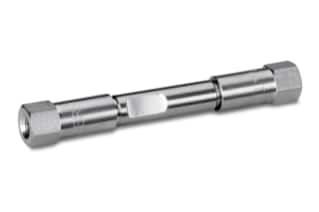
|
Chemistry |
C18 |
|
Separation Mode |
Reversed Phase |
|
Particle Substrate |
Silica |
|
pH Range Min |
2 pH |
|
pH Range Max |
8 pH |
|
Maximum Pressure |
6000 psi (415 Bar) |
|
Endcapped |
Yes |
|
Silanol Activity |
Low |
|
Particle Shape |
Spherical |
|
Particle Size |
5 µm |
|
Endfitting Type |
Waters |
|
Pore Size |
100 Å |
|
Format |
Column |
|
Surface Area |
340 |
|
System |
HPLC |
|
USP Classification |
L1 |
|
Inner Diameter |
4.6 mm |
|
Length |
50 mm |
|
Carbon Load |
16 % |
|
UNSPSC |
41115709 |
|
Brand |
SunFire |
|
Product Type |
Columns |
|
Units per Package |
1 pk |
SunFire C18 Column, 100Å, 5 µm, 4.6 mm X 50 mm, 1/pk
The SunFire C18 Column aids in the development of all-purpose methods at low pH. The SunFire C18 Column's C18 ligand is extremely retentive, particularly for basic chemicals, which makes the lab apparatus ideal for purification and impurity profile studies. You receive the best particle and bonding expertise with the SunFire C18 Column to obtain the best chromatographic performance available in the market.
The higher low pH stability of the SunFire C18 Column extends column lifetime in comparison to the majority of conventional silica-based HPLC columns. The analytical column is dependable equipment that is extremely efficient and gives increased sensitivity, so adding it to your lab has additional benefits. The proprietary, cutting-edge silica synthesis, bonding, end-capping, and packing technologies employed in the production of the SunFire C18 Column enable these features. Superior peak shape performance is provided by the sorbent utilized in the SunFire C18 Column in conjunction with the innovative bonding and end-capping technologies. For better resolution and quantification of acidic, neutral, and basic chemicals at low and intermediate pH ranges, the lab apparatus aids in the achievement of symmetrical peaks.
The SunFire C18 Column has low back pressure, great resolution, and quick response time. It also has further qualities like superb sensitivity, high peak capacity, and extremely little bleed, which, when combined, give you crisp peaks. The SunFire C18 Column may be used with ease in a variety of mass spectrometry applications, and because of its special qualities, it is essential for each lab.
You can explore the Waters catalog or go to our website to shop for lab equipment you require. Additionally, the website gives you access to our global client support team, to which you can refer any questions or issues.
You may also be interested in SunFire C18 VanGuard Cartridge, 100Å, 5 µm, 3.9 mm X 5 mm, 3/pk; SunFire C18 VanGuard Cartridges are used to extend analytical column lifetime and performance by removing particulate contamination from the mobile phase stream. This cartridge is optimized to protect all 4.6 mm I.D. SunFire C18 analytical columns contain 5 µm sorbent particles.
What Is The Turnaround Time For Changing A Column?
In HPLC, changing columns is a practical method development tool that can be done whenever it is necessary. To ensure that there is no air in the column entry, you can attach the replacement column by slowly pouring solvent into the intake fitting from the injector outlet line. Before injecting a sample into a column, we advise you to flush the column with at least six columns of a new solvent to restore equilibrium.